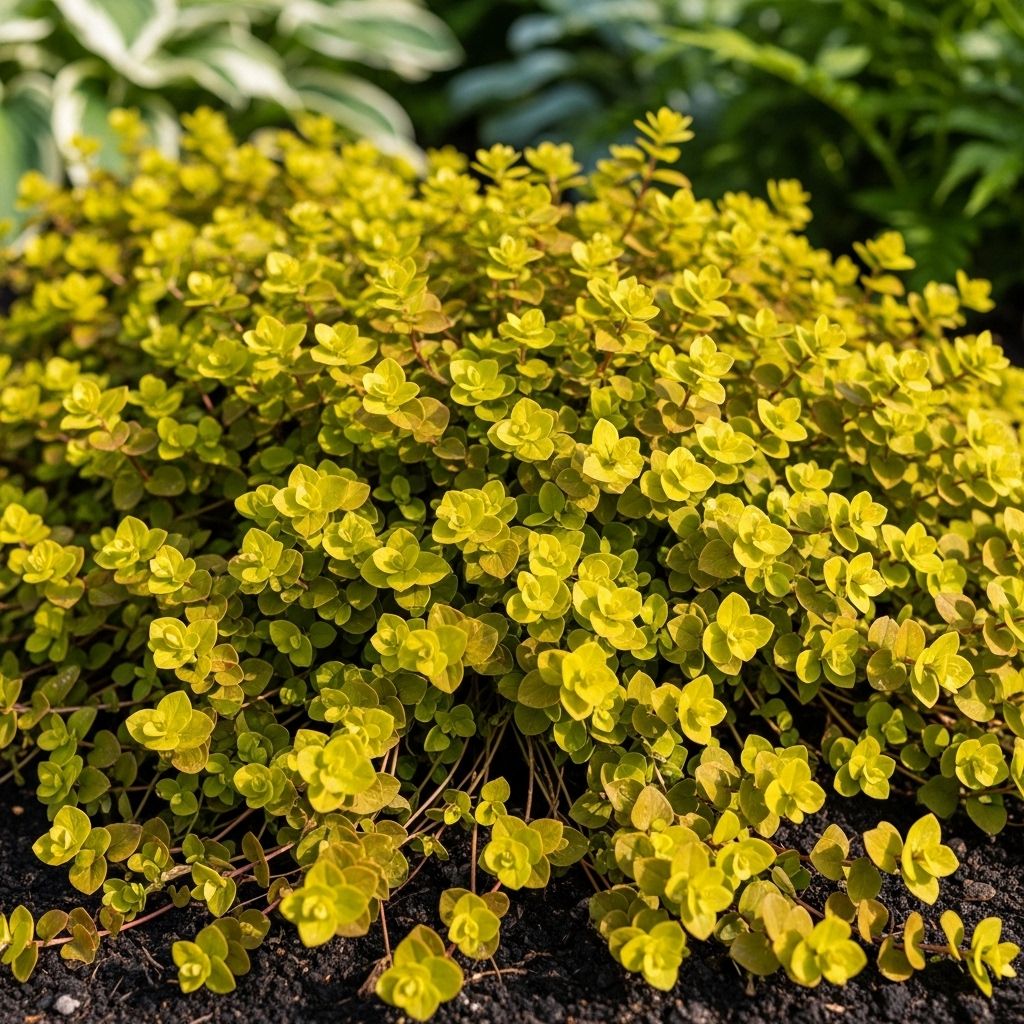Creeping Jenny: Versatile Groundcover for Vibrant Landscapes
Gold-green foliage creates lush mats that suppress weeds in consistently moist spots.

Creeping Jenny (Lysimachia nummularia): A Vibrant and Versatile Groundcover
Creeping Jenny (Lysimachia nummularia), often called moneywort or herb twopence, is a low-growing, fast-spreading, perennial groundcover valued for its vibrant gold to lime-green foliage and adaptable nature. Its beautiful trailing stems and hardiness make it popular for a variety of gardening applications, though careful management is required to prevent invasiveness.
Table of Contents
- About Creeping Jenny
- Plant Characteristics
- Uses in the Garden
- Growing Requirements
- Planting Guidelines
- Maintenance & Care
- Problems: Pests & Disease
- Managing Invasiveness
- Propagation
- Frequently Asked Questions
About Creeping Jenny
Creeping Jenny is native to the British Isles and parts of Europe, thriving along the edges of wetlands, streams, and in moist woodlands. The plant’s botanical name, Lysimachia nummularia, comes from the coin-like appearance of its rounded leaves (nummularia meaning ‘like coins’). Over time, Creeping Jenny has gained popularity worldwide for ornamental use, but it also has a well-deserved reputation for spreading quickly and sometimes aggressively, especially in temperate climates.
Plant Characteristics
- Growth Habit: Creeping Jenny forms mat-like spreads with trailing stems that root at each leaf node, creating dense, ground-hugging carpets 2–4 inches (5–10 cm) tall.
- Leaves: The small, rounded, often shiny leaves are arranged in pairs along thin stems. Leaf color ranges from bright golden yellow (‘Aurea’ cultivar) to lime green or deep green, depending on light exposure.
- Flowers: In summer, single, star-shaped yellow flowers (about 1 inch or 2.5 cm wide, with 5 petals) appear at leaf axils. Although attractive, flowers are often inconspicuous among yellow-foliaged varieties.
- Evergreen/Deciduous: In mild winters, the foliage can remain evergreen, but it may die back and regrow in colder climates.
- Roots: Slender, fibrous roots form wherever the stems touch soil, enhancing the spreading ability.
Uses in the Garden
- Groundcover: Its rapid spread and dense habit make Creeping Jenny perfect for covering large open areas where weed suppression and soil erosion control are needed.
- Containers & Hanging Baskets: The trailing foliage elegantly spills over the edges of pots, window boxes, and raised beds, contrasting beautifully with upright or flowering plants.
- Accent Plant: Its vivid foliage is ideal for brightening shady borders, underplanting around shrubs, or filling spaces between stepping stones.
- Water Features: Thrives at pond edges or in rain gardens, and tolerates consistently moist or even flooded soils.
- Bulb Companions: Often paired with tulips or daffodils, filling in the area after bulb foliage dies back.
Growing Requirements
| Factor | Details |
|---|---|
| Light | Partial to full sun preferred; tolerates light shade. Golden-leaved forms tend to fade in deeper shade. |
| Soil | Fertile, well-draining soils that remain evenly moist. Adapts to clay, loam, or sandy soils if moisture is adequate. |
| Water | Consistently moist soil is best; tolerates occasional flooding and short droughts but may require supplemental watering in dry periods. |
| Hardiness | USDA Zones 3–9, depending on variety and winter severity. |
| Humidity | Performs well in humid and temperate conditions; susceptible to leaf spots in persistently wet, stagnant settings. |
Planting Guidelines
- Choose the Site: Prefer locations with morning sun and afternoon shade, or dappled light all day. Full sun encourages the brightest foliage color, while deep shade may dull the leaves but aid moisture retention.
- Prepare the Soil: Loosen soil to a depth of 6–8 inches, mixing in compost to improve fertility and structure. Ensure the spot drains well but does not become parched.
- Planting Depth: Set transplants so that the rootball is level with the surrounding soil surface. Gently spread out the trailing stems.
- Spacing: For a dense mat, plant 12–18 inches apart; for faster coverage, use closer spacing and thin out later if needed.
- Watering: Irrigate well after planting and keep soil consistently moist (not waterlogged) as roots establish.
- Mulching: Apply a thin layer of organic mulch to retain moisture and suppress weeds during establishment. Avoid piling mulch directly on stems.
Maintenance & Care
- Watering: Regular, deep watering promotes lush growth, especially during hot or dry spells.
- Fertilizing: Apply a balanced, slow-release fertilizer in spring when new growth begins; otherwise, additional feeding is rarely needed.
- Pruning: Trim back stems in late winter or early spring to refresh growth. Prune during the growing season to control spread and shape the plant.
- Dividing: Every few years, divide crowded mats to maintain vigor and prevent overcrowding.
- Mulching: Keeps roots cool, especially important in hot summers or exposed locations.
Seasonal Care Tips
- Spring: Prune old growth, fertilize, remove winter mulch, and monitor soil moisture.
- Summer: Water during droughts and trim back runners to maintain boundaries.
- Fall: Clean up fallen leaves and debris to prevent fungal issues; prune as needed.
- Winter: In harsh climates, Creeping Jenny may die back fully but regrows come spring.
Problems: Pests & Disease
- Pests: Generally resistant, but in damp conditions can occasionally attract slugs, snails, and aphids.
- Disease: Fungal leaf spots and rust can develop if foliage stays wet and air circulation is poor.
- Prevention: Plant in well-drained areas, avoid overcrowding, and trim foliage to enhance airflow. Remove diseased leaves promptly.
Managing Invasiveness
Creeping Jenny is considered invasive in many regions due to its rapid, unchecked spread. Its stems root wherever they touch soil, allowing the plant to quickly engulf the ground and potentially choke out less vigorous neighbors.
- Use in Contained Spaces: Best suited for isolated beds, raised planters, large containers, or where its spread can be controlled (e.g., between paving stones or pond margins).
- Avoid Mixing: Avoid planting with slow-growing or delicate species, as Creeping Jenny may overtake these plants.
- Physical Barriers: Use edging or root barriers in garden beds to confine its spread.
- Regular Maintenance: Pinch or trim runners frequently to prevent unwanted expansion. Remove any sections creeping beyond desired areas.
- Legal Status: Check local guidelines, as it may be restricted or prohibited in naturalized settings in some regions due to invasiveness.
Propagation
- Division: The simplest and most effective propagation method. Lift and divide established clumps in early spring or fall, ensuring several rooted sections per division. Replant immediately.
- Stem Cuttings: Detach healthy runners with a few nodes and pot in moist soil. Rooting typically occurs within weeks as long as the stem remains in contact with damp soil.
- Seed: Less common, as seed set is inconsistent, especially in some cultivars like ‘Aurea’. Germinate seeds in early spring under gentle heat if available.
Frequently Asked Questions (FAQs)
Q: Is Creeping Jenny safe for pets?
A: Creeping Jenny is generally considered non-toxic to cats and dogs. However, ingestion may cause mild digestive upset, so keep curious pets from grazing on landscape plants.
Q: How fast does Creeping Jenny spread?
A: In ideal moisture and light, Creeping Jenny can spread several feet per season through both above-ground runners and rooting stems. Regular pruning is necessary to limit its area.
Q: Does Creeping Jenny keep its color all year?
A: In mild winter climates, foliage can persist year-round, often maintaining vibrant shades. In colder regions, it typically dies back and re-emerges in spring.
Q: Can I grow Creeping Jenny indoors?
A: Yes, it is adaptable as a container houseplant, preferring bright, indirect light and consistently moist (not soggy) soil.
Q: How do I rejuvenate a patch of Creeping Jenny?
A: Prune back old or leggy stems in early spring, thin crowded areas, and optionally divide to stimulate fresh growth and encourage a more compact mat.
Q: Are there variegated types of Creeping Jenny?
A: The most common ornamental form is ‘Aurea’ (golden leaves). Some cultivars offer variations in leaf shape or color, but variegated options are rare.
References
- For further growing advice: consult local extension offices or gardening guides if plant behavior in your region differs from the typical recommendations presented here.
References
- https://sylvangardenslandscape.com/plant-profile/creepying-jenny-plant-profile/
- https://www.gardenersworld.com/how-to/grow-plants/how-to-grow-creeping-jenny/
- https://hort.extension.wisc.edu/articles/golden-creeping-jenny-lysimachia-nummularia-aurea/
- https://www.martinnursery.com/lysimachia-creeping-jenny/
- https://theturquoisehome.com/how-to-grow-creeping-jenny/
Read full bio of Anjali Sayee












